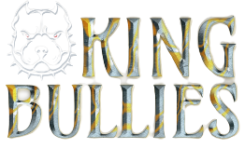Our Forums
Activity › Forums › American Bully Kennels › American Bullies: a detailed overview
-
AuthorPosts
-
February 9, 2022 at 5:05 pm #2006
Alexis
KeymasterPublic1. History
The American Bully evolved from the American Pit Bull Terrier. The APBT has a distinct appearance and disposition. Like any long-standing breed, multiple varieties emerged from the parent breed, with one taking on a unique build and structure that warranted its breed designation. The American Bully breeds.The American Bully breed was influenced by the American Bulldog, English Bulldog, and Olde English Bulldogge.
2. General Appearance
The American Bully breed is distinguished by its compact, robust, thick-set structure. Their looks are a mix of American Pit Bull Terriers and other bully breeds. The head is proportionate to the body, reasonable, and does not restrict normal vision or breathing.
It is a small, smooth-coated dog with considerable strength. It is muscular but lively and agile. Its presence belies its gentle and devoted character.
3. Characteristics
The American bully is first and foremost a buddy, full of vitality and confidence. Despite their intimidating appearance, they are soft-spoken. This breed is great for families. The perfect American bully is athletic. Aggression towards humans is atypical of the breed.
i. Head
The American Bully’s head is distinctive. It’s big and broad, but not out of proportion to the dog. There is a clear, deep stop. The feathers are clean and deep. The cheek muscles are visible and smooth. A broad, blocky, or slightly square muzzle. The muzzle is 25–35 percent of the head’s overall length, and shorter than the skull. The muzzle is straight. The lower jaw is large and deep.
The lower jaw, muzzle, stop, and skull planes should not resemble an English bulldog. ” The nose is big, with wide nostrils. All nasal pigment hues are permitted. The nose and coat colors frequently match.
ii. Teeth
The American bully has a full set of white teeth, evenly spaced.
iii. EyesOval to slightly round eyes, properly spaced and low on the skull. Except blue, other hues are permissible. The haw should be hidden.
i. Ears
Ears are set high and can be natural or trimmed. Wide, prickly ears are not recommended.
ii. Neck
The neck is long and muscular. The crest has a small arch. The neck spreads gradually from the skull to the relaxed shoulders. The neck skin is dewlap-free.
iii. Body
The body is compact, with a wide chest and springing ribs. The chest is large but not deep. The forecast does not extend far ahead of the shoulder. The back is broad and robust. The topline is level. The croup slopes down to the tail base. The loin is wide and short.
The withers to elbow distance is equivalent to the elbows to foot bottom distance. Dogs with a reduced distance between the elbows and their feet are okay, but not preferred.
The distinctive tail is called a “crank” or “pump handle tail.” Straight tails are fine. An extension of the topline, the tail tapers to a point. When moving, the dog’s tail is parallel to the topline. The tail may be raised higher when the dog is excited, but never over the back. The tail is carried low and extends to the hock when the dog is relaxed.
iv. Color
Any color, color pattern, or color combination is acceptable.
v. Gait
The American Bully moves with a lively, confident demeanor, as though expecting something fresh and interesting at any moment. The trot is easy, powerful, and coordinated, with good reach and drive. A modest flex in the backline indicates suppleness. Legs do not turn in or out, nor do feet cross or interfere. Speed increases the convergence of feet on the balancing line. -
AuthorPosts
- You must be logged in to reply to this topic.



